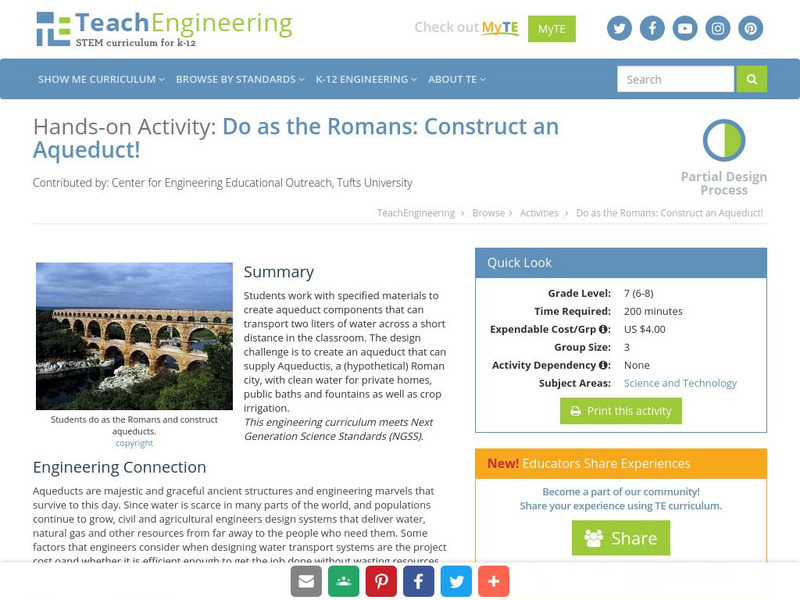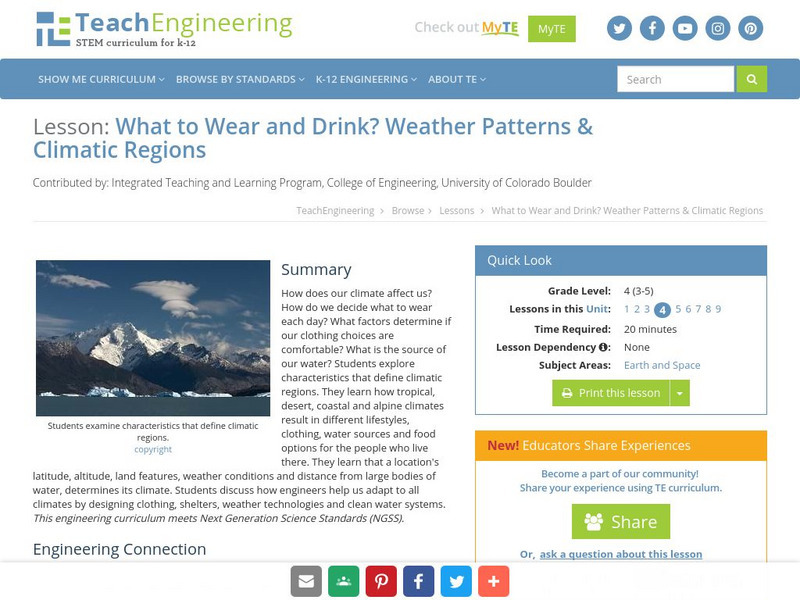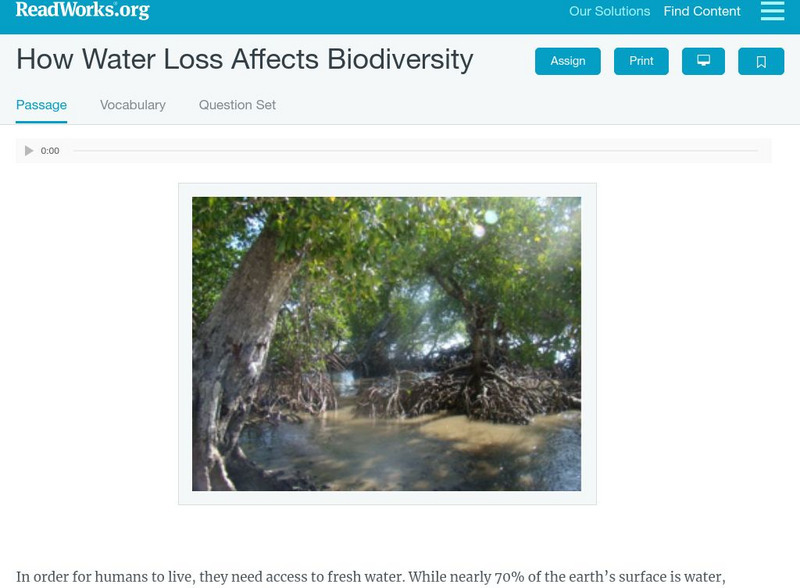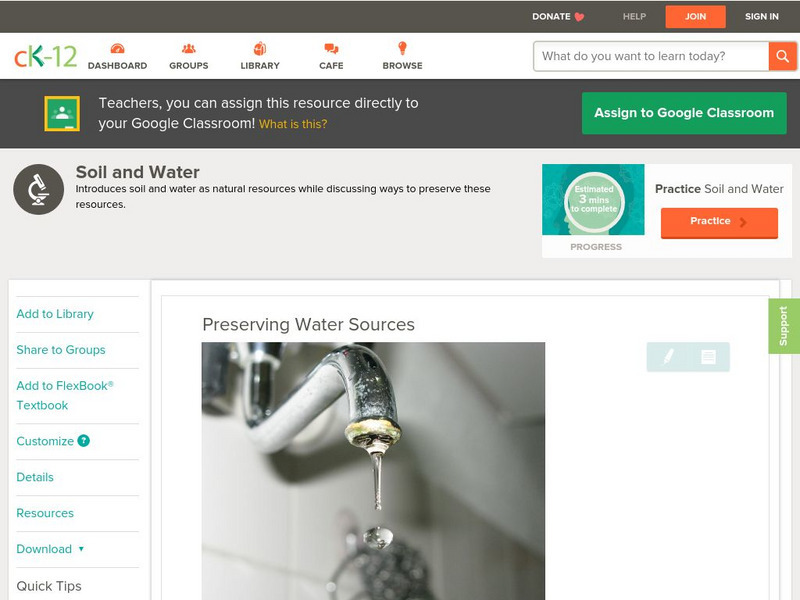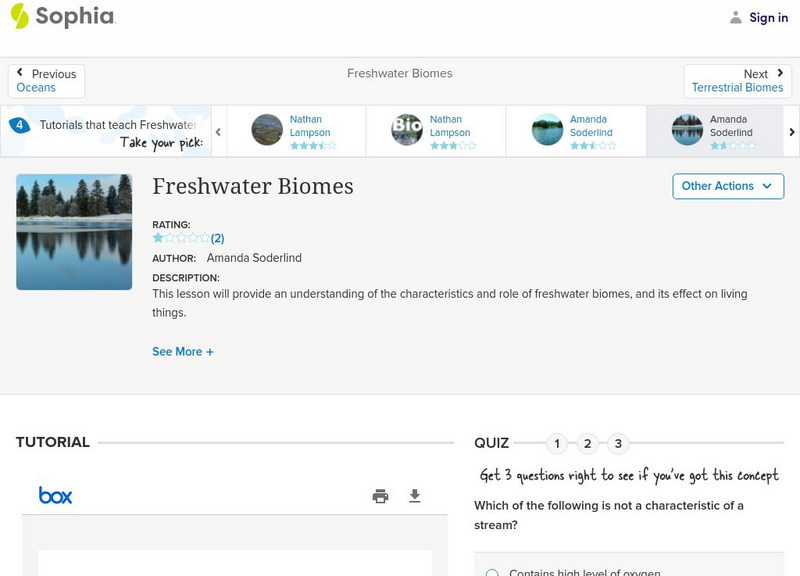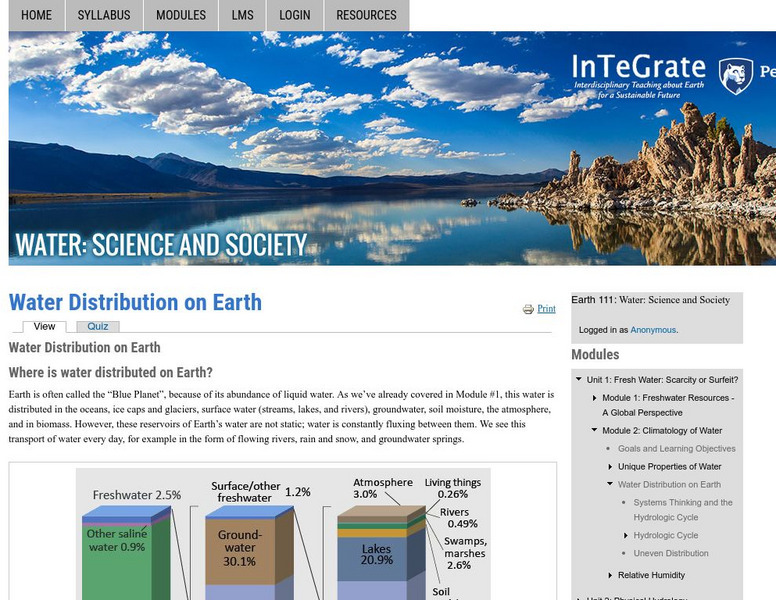TeachEngineering
Teach Engineering: What Happened to the Water? Designing Ways to Get and Clean
In this scenario-based activity, students design ways to either clean a water source or find a new water source, depending on given hypothetical family scenarios. They act as engineers to draw and write about what they could do to...
TeachEngineering
Teach Engineering: Do as the Romans: Construct an Aqueduct!
In this activity, students work with specified materials to create aqueduct components that will transport 2 liters of water across a short distance in their classroom. The goal is to build an aqueduct that will supply Aqueductis, a...
TeachEngineering
Teach Engineering: What to Wear? What to Drink? Weather Patterns and Climatic R
How does our climate affect us? How do we decide what to wear each day? What factors determine if our clothing choices are comfortable? What is the source of our water? Young scholars explore characteristics that define climatic regions....
Other
Ngwa: National Well Owners Association
This site from the National Ground Water Association provides information on ground water, the use of ground water, private water system, well maintenance, and protecting your own well water supply.
Read Works
Read Works: How Water Loss Affects Biodiversity
[Free Registration/Login Required] Students read about how varying amounts of fresh water can affect biodiversity in a region. A question sheet is available to help students build skills in reading comprehension.
Read Works
Read Works: Water, Water, Everywhere!
[Free Registration/Login Required] This nonfiction passes shows the water cycle and describes different types of water on the earth. This passage is a stand-alone curricular piece that reinforces essential reading skills and strategies...
CK-12 Foundation
Ck 12: Life Science: Preserving Water Sources
[Free Registration/Login may be required to access all resource tools.] It might seem like there is plenty of water on Earth, but that's not really the case. Water is a limited resource. That means that it is used faster than it is...
Sophia Learning
Sophia: Freshwater Biomes
Listen to this podcast discussing the similar characteristics of the freshwater biomes of the world. [0:47]
Sophia Learning
Sophia: Freshwater Biomes
This presentation provides information about the characteristics of several different freshwater ecosystems.
Science Education Resource Center at Carleton College
Serc: Microbial Life: Los Angeles and the Future of Mono Lake: Web Quest
Student WebQuest studying biodiversity, preservation, and natural history. Students act as political advisors exploring Mono Lake's life forms the impact humans have on the environment. After researching the issues, students create a...
US Geological Survey
Usgs: Earth's Water Surface Water
This site has everything you might want to know about surface water and things you probably didn't even imagine! Click Home to access the site in Spanish.
Other
Yellowstone.net: Introduction to the Geysers of Yellowstone
This resource provides some history and information about Yellowstone Park and its geysers.
Food and Agricultural Organization of the United Nations
Fao: Discovering Water Re Use
In some part of the world there is not enough fresh water for every use. If things are done differently water re-use can be very effective. Learn here about ways we can change the world. Wastewater, if properly treated can be a resource...
Gulf of Maine Research Institute
Gulf of Maine Research Institute: Katahdin to the Sea: Estuary
This site is an informative article about estuaries. Learn about this interesting water habitat and significance of an estuary.
Other
Circle of Blue: National Security Assessment: Water Scarcity Disrupts Continents
Read this U.S. State Department report which finds a global confrontation between growing water demand and shrinking supplies, in addition to predictions for the next thirty years of water security.
Other
The 71 Percent: The World's Fresh Water Sources
Find out about the distribution of fresh water on Earth.
PBS
Pbs Learning Media: The Water Planet
75% of our earth is covered by water. Water can be found in oceans, lakes, rivers, groundwater, and sea ice. View these captivating photos of our earth showing the different water sources and images of our earth taken by NASA. Background...
CK-12 Foundation
Ck 12: Second Grade Science: A World of Ice and Water
[Free Registration/Login may be required to access all resource tools.] Covers different bodies of water, including rivers, lakes, and oceans.
CK-12 Foundation
Ck 12: Fifth Grade Science: Earth Science: Humans and the Water Supply
[Free Registration/Login may be required to access all resource tools.] Looks at ways that humans use water, why some people don't have enough water, and why poor quality water is a problem.
CK-12 Foundation
Ck 12: Earth Science: Water Distribution
[Free Registration/Login may be required to access all resource tools.] Discusses how water is distributed throughout the world. Includes research assignment.
Other
Cwec: Water Salty or Fresh? (Mini Unit) [Pdf]
This mini-unit is designed to teach students an appreciation of our water resources and how we must not take them for granted if we are to survive.
Pennsylvania State University
Earth 101: Distribution of Water on the Earth's Surface
The distribution of water on the Earth's surface is extremely uneven. Only 3% of water on the surface is fresh; the remaining 97% resides in the ocean. Of freshwater, 69% resides in glaciers, 30% underground, and less than 1% is located...
US Environmental Protection Agency
Epa: Water Sense
After learning simple water-saving tips, students play a game in which they guide "water-efficiency hero Flo" through a maze of pipes, avoiding "water-wasting monsters" and answering questions about water use.



